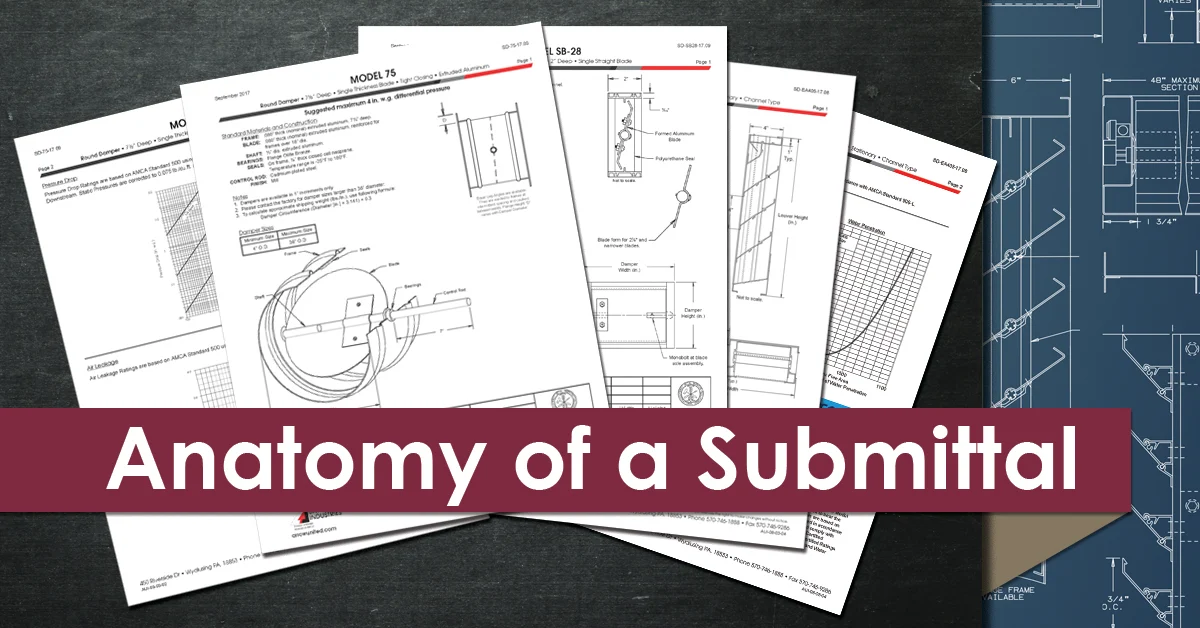Confused by submittals? The best place to start is knowing where to look.
The Submittal
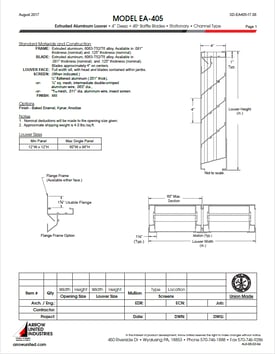 Let’s say you’ve found a louver or a damper. The description on the website says this is the one you’ve been looking for. It might work for your project. How do you know for sure?
Let’s say you’ve found a louver or a damper. The description on the website says this is the one you’ve been looking for. It might work for your project. How do you know for sure?
First off, you should already know what you need the product to do. For example, you already know your louver needs to have a certain level of ventilation, but it also needs to block rainfall or dampen loud noises from heavy machinery.
By knowing what you need, you have already completed the first step.
The next step is checking the product’s submittal. This is where things can get confusing. Submittals give the key details of the product, such as its performance data, the materials used to make it, its minimum and maximum sizes, and other details. Submittals are important, but they can have a lot of information. The key is knowing what to look for.
Let’s start with the basics. The following information is found on every submittal.
Learn and earn with MCDLG and AEC! Visit the MCDLG Campus portal for a list of online courses. 
The Basics - Standard Materials, Drawings, and Min/Max Sizes
 On the first page, you will find a list of standard materials. This section details the materials used for each part of the product, as well as the thickness and size of the material.
On the first page, you will find a list of standard materials. This section details the materials used for each part of the product, as well as the thickness and size of the material.
This list includes the moving parts of adjustable louvers and control dampers, like the linkage assembly. It will also explain how the louver parts are put together. This information is important for the technical aspects of the product, such as understanding its durability or its metal expansion properties.
You can also find drawings on page 1, usually marked with essential information like measurements and dimensions of individual parts. These will give you a sense of what the product looks like and where to find important parts. These drawings will be unique to the product, showing off its individual features.
For louvers, the typical submittal will show detailed pictures of the louver's parts. This can include the louver's blade profile, a top-down view, and any additional parts that can be installed on the louver like a flange frame option.
Dampers will have similar drawings, depicting its blades and linkage assemblies, as well as optional frame types.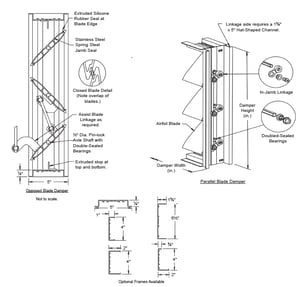
The product's minimum and maximum dimensions are also important. These are often given in inches for one louver or damper panel. They do not reflect the maximum size of multiple products linked together, referred to as an assembly.
There is more to consider when sizing a control damper for a given application. Read "Damper Dimensions" for all the details on damper sizing.
Now that you know the basics, let’s look at how to find important stats on a louver’s air performance. You can find these stats on the second page of the submittal.
Air Performance - Pressure Drop and Free Area
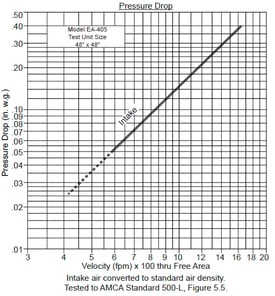
The best place to start is the Pressure Drop Graph. This is a graph with a straight line that compares a rise in pressure drop to air velocity through the product’s free area.
As air velocity increases, pressure drop increases with it. By knowing the general air velocity of your duct work, you can use the line graph to determine the pressure drop of your louver.
Air performance is an important consideration for control dampers. Learn how with "Air Performance and Control Dampers".
Pressure Drop can also be displayed as a table at various air velocities and product sizes. To determine the pressure drop, find the size closest to your louver or damper, then find the required air velocity. This can give you a more precise measurement of the product's pressure drop.
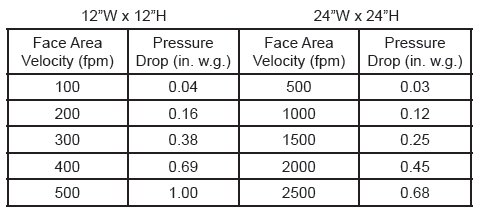
In both instances, pressure drop is expressed as the amount of pressure recorded in inches of water gauge. The higher the pressure drop, the greater the strain on the system as a whole: your system will have to work harder to pull the same amount of air through the louver.
The free area table displays the amount of space between each blade of a louver or damper, for multiple sizes. Row and column headers display the different widths and heights for louvers, expressed in inches or millimeters. The free area is displayed within the table, in square feet or square meters.
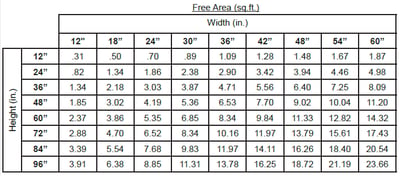
By finding the right width and height, you can find the free area for a louver of a given size. More free area means better ventilation.
With pressure drop and free area, you can determine a louver’s capabilities as an intake or exhaust louver. But what if you need it to block rainfall, too?
For that, you need to find the louver’s Water Penetration and Wind Driven Rain data.
Rain Resistance - Water Penetration and Wind Driven Rain
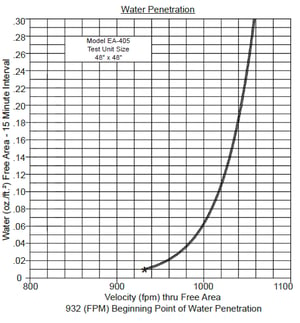 Water penetration and wind driven rain data are specific to louvers. This data is gathered from AMCA testing and pertains to the AMCA seals for Water Penetration and Wind Driven Rain. Learn more about AMCA's testing methods with these articles:
Water penetration and wind driven rain data are specific to louvers. This data is gathered from AMCA testing and pertains to the AMCA seals for Water Penetration and Wind Driven Rain. Learn more about AMCA's testing methods with these articles:
Water penetration is displayed on a graph with a curved line that starts at the louver’s beginning point of water penetration.
The graph compares the amount of water passing through the free area (in ounces per square feet) to air velocity through the louver’s free area (in feet per minute).
You can use the curved line to determine the louver’s capabilities to resist water at a given average air velocity. The beginning point of water penetration is also listed below the graph. If there is no line on the graph, it means the beginning point of water penetration exceeds 1250 feet per minute.
Wind driven rain data is displayed in a table that contains all the data collected from the wind driven rain test: Core Ventilation (meters per second), Free Area Ventilation (cubic feet per minute), Free Area Velocity (feet per minute), an Effectiveness Ratio (percentage of water deflected), and an Effectiveness Rating Class (Letter rating, A through D).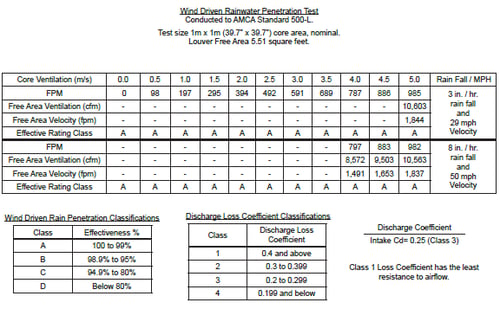
The submittal will have additional information beneath the Wind Driven Rain table, such as the Discharge Loss Coefficient and tables explaining the Effectiveness Rating classes and the louver’s discharge loss coefficients.
Air Leakage Data and the Air Leakage Rating
For control dampers and adjustable louvers, the submittal will have an Air Leakage graph that displays how much air can escape from the product with its blades closed. This is expressed a curved line, comparing static pressure drop (in inches of water gauge) to the amount of air leakage (in cubic feet per minute per square foot).
The graph is accompanied by an explanation of the air leakage test, including the size of product used and the amount of torque used to keep the blades closed.
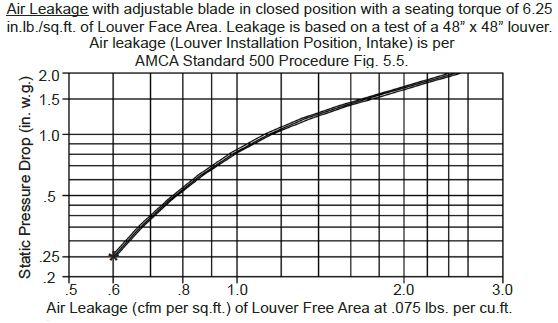
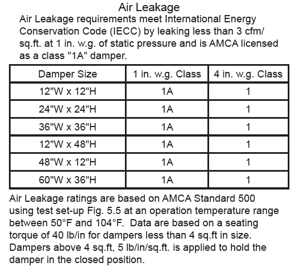
You may also find the product's Air Leakage Rating displayed as a table on the submittal. The air leakage rating is part of AMCA's seal for Air Leakage, signifying the air leakage rating for the control damper or adjustable louver at various sizes and operating pressures.
The Air Leakage Rating table will be accompanied by an Air Leakage Classification Table that breaks down each air leakage rating.
This shows the amount of air allowed through the closed blades, dependent on air pressure. The lower the rating, the less air allowed through the closed damper or louver.
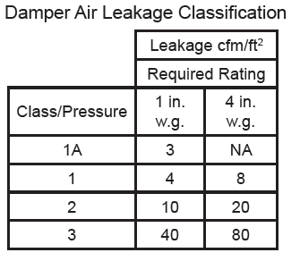
For example, to attain the best air leakage rating, Class 1A, the damper cannot allow more than 3 cubic feet of air per minute per square foot of damper or louver area. If the amount of leakage exceeds this, then the rating moves down to Class 1, then Class 2, and then Class 3.
The damper or louver must complete AMCA's Air Leakage test to receive an air leakage rating. Learn how air leakage affects system performance with "Air Leakage".
Sound Loss and Sound Attenuation
For acoustical louvers, you want to know how well the louver can dampen loud noises. That’s where the Sound Transmission Loss and Sound Attenuation tables come in. The Sound Transmission Loss table displays the sound loss (in decibels) and the free field noise reduction for sounds at various octave bands and frequencies.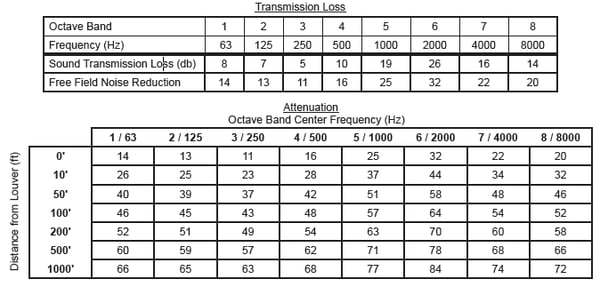
The Sound Attenuation table shows both sound loss and sound energy reduction as a function of distance (in feet). With these data points, you can get a better sense of how well the acoustical louver will block loud noises from escaping.
Submittals are filled with valuable information about the product, information that will be vital in deciding if it works for your applications. They can be easy to read, once you know what you’re looking for.
For more on louver and damper selection, check out these Newsstand articles:
- Important Terms for Louvers and Dampers
- Damper Dimensions
- Three Common Types of Louvers
Different manufacturers will use different layouts for their submittals, but they will contain essential information on the product. Have you reviewed any submittals before? Are there any traits you look for in a submittal? Share your thoughts in the Comments section. MCDLG wants to hear from you!
Need help right away? Contact MCDLG. We are ready to help you.
.webp?width=91&height=70&name=MCDLG%20Logo%20(Resize).webp)
